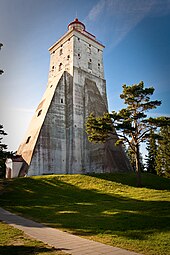Kõrgessaare (rural municipality)
| Kõrgessaare | |||
|
|||
| State : |
|
||
| Circle : |
|
||
| Coordinates : | 58 ° 57 ' N , 22 ° 28' E | ||
| Area : | 379.5 km² | ||
| Residents : | 1,284 (2010) | ||
| Population density : | 3 inhabitants per km² | ||
| Time zone : | EET (UTC + 2) | ||
| Community type: | former rural community | ||

|
|||
Kõrgessaare (German: Hohenholm ) is a former rural community in the Estonian district of Hiiu with an area of 379.5 km², approx. 18 km from the island's capital Kärdla . It had 1284 inhabitants (January 1, 2010). In 2013 it merged with Kärdla to form the rural community of Hiiu , which was merged into the rural community of Hiiumaa in 2017 .
Villages
In addition to the main town Kõrgessaare ( Kõrgessaare alevik ) for rural municipality includes the villages ( külad ) Heigi , Heiste , Heistesoo , Hirmuste , Hüti , Isabella , Jõeranna , Jõesuu , Kalana , Kaleste , Kanapeeksi , Kauste , Kidaste , Kiduspe , Kiivera , Kodeste , Koidma , Kopa , Kurisu , Kõpu , Laasi , Lauka , Lehtma , Leigri , Lilbi , Luidja , Malvaste , Mangu , Mardihansu , Meelste , Metsaküla , Mudaste , Mägipe , napi , Nõmme , Ogandi , Ojaküla , Otste , Palli , Paope , Pihla , Poama , Puski , Reigi , Risti , Rootsi , Sigala , Suurepsi , Suureranna , Sülluste , Tahkuna , Tammistu , Tiharu , Ülendi , Viita , Viitasoo , Vilima and Villamaa .
Community partnerships
There was a partnership with the Dragsfjärd municipality in Finland .
history
Kõrgessaare was first mentioned in 1532. There was already an estate here in 1552, which is one of the oldest on Hiiumaa Island . In the years 1909–1914 the Belgian public limited company "Viscosa" founded an artificial silk factory. After the factory, the settlement was also called Viskoosa , which has been popularly preserved.
The landscape on the northwest coast of the island Hiiumaa with its untouched nature and the lighthouses of Kõpu , Ristna and Tahkuna was particularly worth seeing .
Estonia Memorial
The memorial for those who died in the sinking of the Estonia ferry in 1994 is on the beach of the Tahkuna peninsula near the lighthouse at the point in Estonia that is closest to the site of the disaster on Estonia . From here you have a wide view over the sea. The memorial was built by Mati Karmin in 1995 , is nine and a half meters high and is primarily dedicated to those children who perished on the Estonia . A slanted filigree sculpture rises out of a pile of stones, made of four narrow rusting steel girders and topped off by a square made of four narrow steel girders. In this open square hangs a long, silver-plated steel cross that is swingingly attached and has a bronze bell at the lower end. Mourners who come to the memorial can put a stone on the cairn and ring the bell to bring the deceased closer emotionally. When there is a storm the bell starts to ring; this awakens the feeling in the mourners that the souls of the deceased are ringing this bell. That is why the bronze bell is also known as the soul bell .
Web links
- Tourism in Kõrgessaare
- Memorial in Tahkuna


